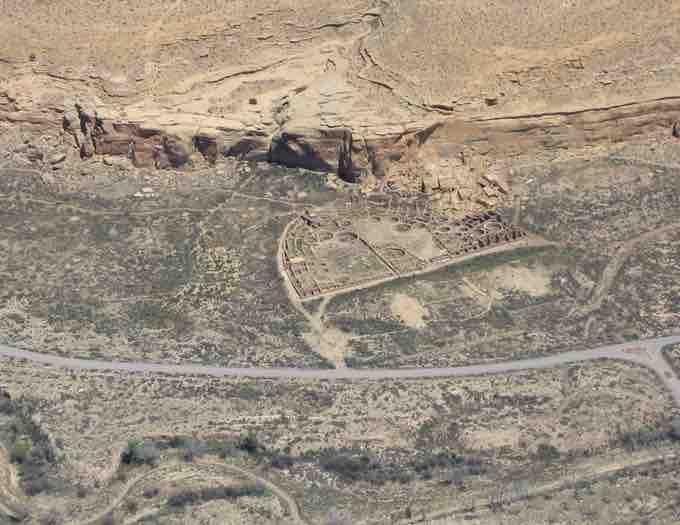The Anasazi (1000 BCE–700 CE) are the ancestors of today's Pueblo tribes. Their culture formed in the American southwest after the cultivation of corn was introduced from Mexico around 1200 BCE. Additionally, the Navajo and Apache peoples emigrated from Northern Canada to the Southwest sometime after 1000 CE. People of this region developed an agrarian lifestyle, cultivating food, storage gourds, and cotton with irrigation or xeriscaping techniques. They lived in sedentary towns, so pottery used to store water and grain was ubiquitous. For hundreds of years, the Anasazi created utilitarian grayware and black-on-white pottery, as well as orange or red ceramics. Turquoise, jet, and spiny oyster shell were traditionally used by Ancestral Pueblo for jewelry and sophisticated inlay.
Anasazi Architecture
Southwest architecture includes cliff dwellings (multi-story settlements carved from living rock), pit houses, and adobe and sandstone pueblos. One of the most elaborate and largest ancient settlements is Chaco Canyon in New Mexico, which includes 15 major complexes of sandstone and timber. These are connected by a network of roads. The largest of these settlements, Pueblo Bonito, contains over 800 rooms .

Pueblo Bonito
The impressive Pueblo Bonito was built by the Ancestral Puebloans as one of several settlements at Chaco Canyon.
Hopi Culture
The Hopi culture emerged in the Southwest in the fourteenth century. Hopi communities created ollas, dough bowls and food bowls of different sizes for daily use, but they also made more elaborate ceremonial mugs, jugs, ladles, seed jars and vessels for ritual use. These were usually finished with polished surfaces and decorated with black painted designs.
Among Hopi ritual art is the kachina figure, which is to instruct young girls and new brides about katsinas or katsinam, the immortal beings that bring rain, control other aspects of the natural world and society, and act as messengers between humans and the spirit world.
Hopi Kachina figure
The Kachina figure originated in the eighteenth century as a flat object with an almost indistinguishable shape that suggested a head and contained minimal body paint. By the late nineteenth century, it had assumed a ore realistic appearance.
Navajo Culture
Art in the Navajo culture is traditionally gender-based. Men, seen as static in nature, create sand paintings for healing rituals. Because the pattern must be precise if the infirm person is to be cured, men are believed to be better suited for this work. Because sand paintings must be destroyed at the end of the ritual, tradition dictates that the designs not be photographed or otherwise documented. Women, on the other hand, are seen as more dynamic in nature and, thus, better suited for the creation of woven fabrics, such as blankets and rugs, who patterns do not have to be exact. Unlike sand paintings, blankets and rugs are made to be long-lasting, and, therefore, may be photographed.
Probably Bayeta-style Blanket with Terrace and Stepped Design
Navajo. 1870-80.
Hohokam Culture
Around 200 CE the Hohokam culture developed in Arizona as the ancestors of the Tohono O'odham and Akimel O'odham or Pima tribes. The Hohokam are credited with being the first culture to master acid etching. Artisans produced jewelry from shell, stone, bone and carved stone figures. Pottery and textile production also flourished .

Hohokam Etched Shell
This shell was produced by the Hohokam culture of the Southwest.